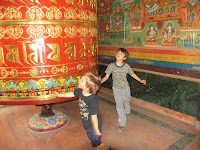
Continuing the Buddhist Trifecta . .
- What is Saranth?
- What is a Prayer wheel?
- What is Theravada Buddhism?
1. Saranth is the place where Gautauma Buddha first began his teaching of the Dharma or the Path. About 5 weeks after his Enlightenment at Bodh Gaya, Gautauma Buddha was traveling to meet some friends. On the way, he came across the unpassable
When you hear monks say, “I seek refuge in the Buddha, the Dharma, and the Sangha,” they are saying, “I look to the Master, the Teachings, and the Community” for assistance on my journey to
2. A prayer wheel can be large or small, and contains individual slips of paper upon which are written unique prayers. The prayer wheel is hollow and usually shaped like a cylinder, placed on an axis from which to spin the wheel. When the wheel is spun, the individual slips of paper in the drum move around and the prayers are lifted towards the heavens. When illiteracy was common, prayer wheels were a way for the community to send forth written prayers, without having to read the prayer.
3. Theravada Buddhism is the type of Buddhism practiced in Southeast Asian countries to include

“General Chang, You cannot liberate me. I can only liberate myself.”
- His Holiness, the 14th Dalai Lama of
OWR


No comments:
Post a Comment